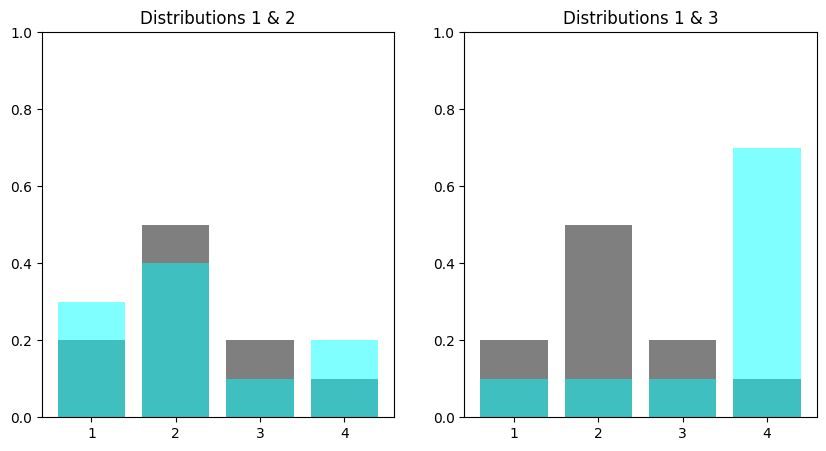Kullback-Leibler (KL) Divergence¶
Kullback-Leibler (KL) Divergence is a measure of how one probability distribution is different from a second, reference probability distribution. Smaller KL Divergence values indicate more similar distributions and, since this loss function is differentiable, we can use gradient descent to minimize the KL divergence between network outputs and some target distribution. As an example, this can be used in Variational Autoencoders (VAEs), and reinforcement learning policy networks such as Trust Region Policy Optimization (TRPO).
In MXNet Gluon, we can use KLDivLoss to compare categorical distributions. One important thing to note is that the KL Divergence is an asymmetric measure (i.e. KL(P,Q) != KL(Q,P)): order matters and we should compare our predicted distribution with our target distribution in that order. Another thing to note is that there are two ways to use KLDivLoss
that depend on how we set from_logits (which has a default value of true).
As an example, let’s compare a few categorical distributions (dist_1, dist_2 and dist_3), each with 4 categories.
[1]:
from matplotlib import pyplot as plt
import mxnet as mx
import numpy as np
idx = np.array([1, 2, 3, 4])
dist_1 = np.array([0.2, 0.5, 0.2, 0.1])
dist_2 = np.array([0.3, 0.4, 0.1, 0.2])
dist_3 = np.array([0.1, 0.1, 0.1, 0.7])
plt.figure(figsize=(10,5))
plt.subplot(1,2,1)
plt.ylim(top=1)
plt.bar(idx, dist_1, alpha=0.5, color='black')
plt.bar(idx, dist_2, alpha=0.5, color='aqua')
plt.title('Distributions 1 & 2')
plt.subplot(1,2,2)
plt.ylim(top=1)
plt.bar(idx, dist_1, alpha=0.5, color='black')
plt.bar(idx, dist_3, alpha=0.5, color='aqua')
plt.title('Distributions 1 & 3')
[1]:
Text(0.5, 1.0, 'Distributions 1 & 3')

We can see visually that distributions 1 and 2 are more similar than distributions 1 and 3. We’ll confirm this result using KLDivLoss. When using KLDivLoss with the default from_logits=True we need:
our predictions to be parameters of a logged probability distribution.
our targets to be parameters of a probability distribution (i.e. not logged).
We often apply a softmax operation to the output of our network to get a distribution, but this can have a numerically unstable gradient calculation. As as stable alternative, we use log_softmax and so this is what is expected by KLDivLoss when from_logits=True. We also usually work with batches of
predictions, so the predictions and targets need to have a batch dimension (the first axis by default).
Since we’re already working with distributions in this example, we don’t need to apply the softmax and only need to apply log. And we’ll create batch dimensions even though we’re working with single distributions.
[2]:
def kl_divergence(dist_a, dist_b):
# add batch dimension
pred_batch = mx.np.expand_dims(mx.np.array(dist_a), axis=0)
target_batch = mx.np.expand_dims(mx.np.array(dist_b), axis=0)
# log the distribution
pred_batch = mx.np.log(pred_batch)
# create loss (assuming we have a logged prediction distribution)
loss_fn = mx.gluon.loss.KLDivLoss(from_logits=True)
divergence = loss_fn(pred_batch, target_batch)
return divergence.item()
[3]:
print("Distribution 1 compared with Distribution 2: {}".format(
kl_divergence(dist_1, dist_2)))
print("Distribution 1 compared with Distribution 3: {}".format(
kl_divergence(dist_1, dist_3)))
print("Distribution 1 compared with Distribution 1: {}".format(
kl_divergence(dist_1, dist_1)))
Distribution 1 compared with Distribution 2: 0.025424212217330933
Distribution 1 compared with Distribution 3: 0.2656409740447998
Distribution 1 compared with Distribution 1: 0.0
[04:48:32] /work/mxnet/src/storage/storage.cc:202: Using Pooled (Naive) StorageManager for CPU
As expected we see a smaller KL Divergence for distributions 1 & 2 than 1 & 3. And we also see the KL Divergence of a distribution with itself is 0.
from_logits=False¶
Alternatively, instead of manually applying the log_softmax to our network outputs, we can leave that to the loss function. When setting from_logits=False on KLDivLoss, the log_softmax is applied to the first argument passed to loss_fn. As an example, let’s assume our network outputs us the values
below (favorably chosen so that when we softmax these values we get the same distribution parameters as dist_1).
[4]:
output = mx.np.array([0.39056206, 1.3068528, 0.39056206, -0.30258512])
We can pass this to our KLDivLoss loss function (with from_logits=False) and get the same KL Divergence between dist_1 and dist_2 as before, because the log_softmax is applied within the loss function.
[5]:
def kl_divergence_not_from_logits(dist_a, dist_b):
# add batch dimension
pred_batch = mx.np.expand_dims(mx.np.array(dist_a), axis=0)
target_batch = mx.np.expand_dims(mx.np.array(dist_b), axis=0)
# create loss (assuming we have a logged prediction distribution)
loss_fn = mx.gluon.loss.KLDivLoss(from_logits=False)
divergence = loss_fn(pred_batch, target_batch)
return divergence.item()
[6]:
print("Distribution 1 compared with Distribution 2: {}".format(
kl_divergence_not_from_logits(output, dist_2)))
Distribution 1 compared with Distribution 2: 0.025424206629395485
Advanced: Common Support¶
Occasionally, you might have issues with KLDivLoss. One common issue arises when the support of the distributions being compared are not the same. ‘Support’ here is referring to the values of the distribution which have a non-zero probability. Conveniently, all our examples above had the same support, but we might have a case where some categories have a probability of 0.
[7]:
dist_4 = np.array([0, 0.9, 0, 0.1])
[8]:
print("Distribution 4 compared with Distribution 1: {}".format(
kl_divergence(dist_4, dist_1)))
Distribution 4 compared with Distribution 1: nan
We can see that the result is nan, which will obviously cause issues when calculating the gradient. One option is to add a small value epsilon to all of the probabilities, and this is already done for the target distribution (using the value of 1e-12).
Advanced: Aggregation¶
One minor difference between the true definition of KL Divergence and the result from KLDivLoss is how the aggregation of category contributions is performed. Although the true definition sums up these contributions, the default behaviour in MXNet Gluon is to average terms along the batch dimension. As a result, the KLDivLoss output will be smaller than the true definition by a factor of the number of categories.
[9]:
true_divergence = (dist_2*(np.log(dist_2)-np.log(dist_1))).sum()
print('true_divergence: {}'.format(true_divergence))
true_divergence: 0.10169682996275987
num_categories = dist_1.shape[0]
divergence = kl_divergence(dist_1, dist_2)
print('divergence: {}'.format(divergence))
print('divergence * num_categories: {}'.format(divergence * num_categories))
